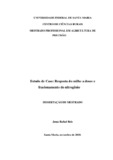| dc.creator | Reis, Jonas Rafael | |
| dc.date.accessioned | 2019-02-25T18:05:03Z | |
| dc.date.available | 2019-02-25T18:05:03Z | |
| dc.date.issued | 2018-11-30 | |
| dc.identifier.uri | http://repositorio.ufsm.br/handle/1/15745 | |
| dc.description.abstract | Since the antiquity in agriculture, yield increase has been conditioned by the use of new techniques derived from increasing man's knowledge. In recent farming is not different, that is, in times of precision farming these techniques are even more evident in the most diverse crops. What has been verified in the last years in the corn crop is the possibility that the more recent hybrids can response to the nitrogen management with late application, especilly at the time of flowering of the crop, probably influencing positively the final grain weight and improving the yield. For this, a work was developed in a field located in the countryside of the city of Carazinho-RS, with the hybrid "AGROCERES 9025 PRO3®". The area selected for the work was selected using yield maps trough yield monitor and Electrical Conductivity map provided through Veris CE® to attest the homogeneous condition for both treatments. The treatment 1 (T1) used by the farmer consisted of 180 kg / ha of Nitrogen (N) in the form of urea in 3 doses: 54 kg / ha in V4, 63 kg / ha in V6 and 63 kg / ha in V8. The treatment 2 (T2) was 54 kg / ha in V4, 81 kg / ha in V6, 0 kg / ha in V8 and 45 kg / ha in VT. The applications were carried out with the machine called "Imperador 3.0" that had a hydraulic system that allows the machine to increase the soil clearance in 40 cm, allowing this late application. To verify the results, yield maps were used using mass flow sensors installed in the farmer's combine. With these files it was verified that the yield in the proposed treatment presented a positive response in relation to the treatment of the farmer. | eng |
| dc.language | por | por |
| dc.publisher | Universidade Federal de Santa Maria | por |
| dc.rights | Attribution-NonCommercial-NoDerivatives 4.0 International | * |
| dc.rights.uri | http://creativecommons.org/licenses/by-nc-nd/4.0/ | * |
| dc.subject | Mapas de produtividade | por |
| dc.subject | Condutividade elétrica | por |
| dc.subject | Produtividade | por |
| dc.subject | Yield maps | eng |
| dc.subject | Electrical conductivity | eng |
| dc.subject | Yield | eng |
| dc.title | Estudo de caso: resposta do milho a doses e fracionamento do nitrogênio | por |
| dc.title.alternative | Case study: maize response to nitrogen doses and fractionation | eng |
| dc.type | Dissertação | por |
| dc.description.resumo | Desde a antiguidade os aumentos de produtividade na agricultura foram condicionados ao uso de novas técnicas oriundas do aumento do conhecimento do homem. Na agricultura recente não é diferente, ou seja, em tempos de agricultura de precisão estas técnicas estão ainda mais evidentes nas mais diversas culturas. O que se tem percebido nos últimos anos na cultura do milho (Zea mays) é a possibilidade que híbridos mais recentes podem apresentar resposta ao manejo de nitrogênio com aplicação tardia, especialmente na época de florescimento da cultura, influenciando positivamente no peso de grãos final e devido a isso na produtividade. Para isso foi realizado um trabalho em um talhão localizado no interior do munícipio de Carazinho-RS, onde se utilizou o híbrido “AGROCERES 9025 PRO3®”. A área escolhida para realização do trabalho foi selecionada empregando mapas de produtividade fornecidos pelo monitor de colheita e Condutividade Elétrica fornecidos através do Veris CE® para atestar a condição homogênea para ambos os tratamentos. O tratamento 1 (T1) utilizado pelo produtor consistia no parcelamento de 180 kg/ha de Nitrogênio (N) na forma do produto (ureia 45%) em 3 doses: 54 kg/ha em V4, 63 kg/ha em V6 e 63 kg/ha em V8. O tratamento 2 (T2) foi de 54 kg/ha em V4, 81 kg/ha em V6, 0 kg/ha em V8 e 45 kg/ha em VT. As aplicações foram realizadas com a máquina denominada “Imperador 3.0” que possuía um sistema de regulagem hidráulica de vão livre que aumenta em 40 cm a distância para o solo, possibilitando esta aplicação tardia. Para verificação dos resultados foram utilizados mapas de produtividade realizados através de sensores de fluxo de massa instalados na colhedora do agricultor. Com estes arquivos constatou-se que a produtividade no tratamento proposto apresentou resposta positiva em relação ao tratamento do produtor. | por |
| dc.contributor.advisor1 | Bredemeier, Christian | |
| dc.contributor.advisor1Lattes | http://lattes.cnpq.br/0364795290228832 | por |
| dc.contributor.referee1 | Marchesan, Enio | |
| dc.contributor.referee1Lattes | http://lattes.cnpq.br/2740617028203037 | por |
| dc.contributor.referee2 | Schneider, Evandro Pedro | |
| dc.contributor.referee2Lattes | http://lattes.cnpq.br/5439999035812296 | por |
| dc.creator.Lattes | http://lattes.cnpq.br/6991236122951578 | por |
| dc.publisher.country | Brasil | por |
| dc.publisher.department | Tecnologia em Agricultura de Precisão | por |
| dc.publisher.initials | UFSM | por |
| dc.publisher.program | Programa de Pós-Graduação em Agricultura de Precisão | por |
| dc.subject.cnpq | CNPQ::CIENCIAS AGRARIAS::AGRONOMIA | por |
| dc.publisher.unidade | Colégio Politécnico da UFSM | por |



